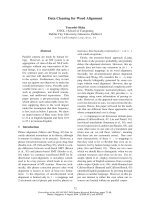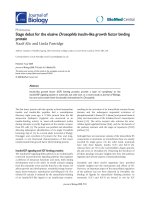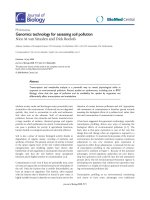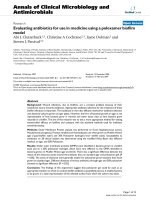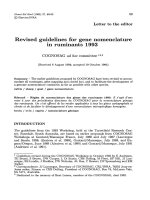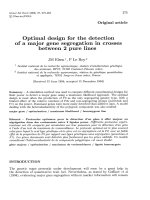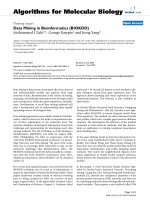Báo cáo sinh học: "Data transformation for rank reduction in multi-trait MACE model for international bull comparison" doc
Bạn đang xem bản rút gọn của tài liệu. Xem và tải ngay bản đầy đủ của tài liệu tại đây (94.52 KB, 14 trang )
Genet. Sel. Evol. 40 (2008) 295–308 Available online at:
c
INRA, EDP Sciences, 2008 www.gse-journal.org
DOI: 10.1051/gse:2008004
Original article
Data transformation for rank reduction
in multi-trait MACE model for international
bull comparison
Joaquim Tarres
1, 2∗
, Zengting Liu
1
, Vincent Ducrocq
2
,
Friedrich R
einhardt
1
, Reinhard Reents
1
1
VIT, Heideweg 1, 29283 Verden, Germany
2
UR337, Station de génétique quantitative et appliquée, INRA,
78352 Jouy-en-Josas Cedex, France
(Received 19 March 2007; accepted 5 November 2007)
Abstract – Since many countries use multiple lactation random regression test day models in
national evaluations for milk production traits, a random regression multiple across-country
evaluation (MACE) model permitting a variable number of correlated traits per country should
be used in international dairy evaluations. In order to reduce the number of within country
traits for international comparison, three different MACE models were implemented based on
German daughter yield deviation data and compared to the random regression MACE. The
multiple lactation MACE model analysed daughter yield deviations on a lactation basis reducing
the rank from nine random regression coefficients to three lactations. The lactation breeding
values were very accurate for old bulls, but not for the youngest bulls with daughters with
short lactations. The other two models applied principal component analysis as the dimension
reduction technique: one based on eigenvalues of a genetic correlation matrix and the other
on eigenvalues of a combined lactation matrix. The first one showed that German data can be
transformed from nine traits to five eigenfunctions without losing much accuracy in any of the
estimated random regression coefficients. The second one allowed performing rank reductions
to three eigenfunctions without having the problem of young bulls with daughters with short
lactations.
rank reduction / principal components / genetic correlation matrix / multiple across
country evaluation / dairy cattle
1. INTRODUCTION
The multiple across country evaluation (MACE) [17] methodology is cur-
rently used for international dairy bull comparisons. Estimated breeding values
from each country are deregressed to obtain a value analogous to daughter
yield deviations (DYD) for bulls that have daughters with records. Despite the
∗
Corresponding author:
Article published by EDP Sciences and available at
or />296 J. Tarres et al.
fact that only a single EBV per bull is permitted for each country in inter-
national genetic evaluation, the current MACE has a large number of equa-
tions, since each evaluated sire will, conceptually, have a breeding value for all
traits, i.e. for all countries, although it might have daughters only in one. Tradi-
tionally, the corresponding genetic covariance matrices have been considered
unstructured, i.e. for k countries there were k(k + 1)/2 distinct (co)variance
components to be estimated. For example, when the current Interbull Holstein
evaluation run for production traits includes 26 countries, the (co)variance ma-
trix of genetic effects involves 325 correlations. By and large, restrictions on
estimates are imposed only to ensure that estimates were within the parameter
space, i.e. that all variances and conditional variances are positive, that all cor-
relation estimates are in the range of –1 to +1, and that all partial correlations
are consistent with each other [13]. In statistical terms, this is equivalent to
the requirement that the estimated covariance matrix is positive semidefinite,
i.e. that none of its eigenvalues is negative.
In contrast, other areas of statistics have long since assumed and estimated
structured covariance matrices. A well-designed structural model for genetic
covariances uses information, external to the data, to explain genetic covari-
ability in terms of few parameters, leading to more precise estimates of ge-
netic correlations between countries [16]. For example, in international dairy
sire evaluations, traits are currently defined according to country borders. How-
ever, similarity in production systems between herds in different countries de-
pends not only on geographical proximity but also on climatic conditions, on
management practices, and on the genetic composition of the cow popula-
tion. If information is available about these variables, it can be used to ex-
plain the genetic covariance structure between countries. Rekaya et al. [16],
Minéry et al. [14] and Leclerc et al. [6] have proposed structural models in
order to reduce the number of parameters to be estimated across countries.
On the contrary, principal component (PC) analysis is widely used as a
dimension reduction technique, but so far has had only limited applications
in quantitative genetic analyses. PC analysis requires estimating eigenvectors
and -values of covariance matrices [3]. Eigenvectors define independent lin-
ear functions of the variables considered, the so-called principal components,
that successively explain the maximum amount of variation, measured by the
corresponding eigenvalues. This implies that for a given number of compo-
nents considered, PC approximate the multivariate data most accurately. It fol-
lows that PC with variances (eigenvalues) close to zero contribute virtually no
information to the analysis that is not already contained in the PC with larger
eigenvalues. Hence, these components can be ignored resulting in equivalent
Rank reduction in MT-MACE models 297
analyses involving fewer variables, i.e. traits or countries, and often reduced
sampling variation. Reducing the dimension of analyses by considering fewer
variables can considerably decrease computational requirements. Different au-
thors have proposed the reduction of the number of parameters to be es-
timated across countries using PC analysis, and the closely related factor
analysis [5,10–13].
Since more and more countries have upgraded their national genetic evalu-
ation system to a multiple trait model or a multiple lactation random regres-
sion test day model (RRTDM) [7], differences between models for national
and international evaluations have become increasingly evident. In order to
optimise genetic evaluation models for both national and international evalu-
ations, Sullivan and Wilton [18] and Liu et al. [9] proposed a multiple trait
MACE (MT-MACE) model for international bull comparison. This model ex-
tended the current single trait MACE (ST-MACE) allowing a variable number
of correlated traits for countries using a multiple trait model in national genetic
evaluation. Although the MT-MACE model can better utilise the information
derived from the RRTDM in national genetic evaluation than the ST-MACE
model, the huge size of the MT-MACE system can be a limiting factor for
international genetic evaluation involving all dairy populations. In order to re-
duce the size of the MT-MACE system, it is even more necessary than for
the ST-MACE to apply rank reduction techniques to find intermediate MACE
models that can be a reasonable compromise between feasibility and accuracy.
In parallel to international bull comparison, France and Germany strength-
ened their collaboration at the end of 2005 in a joint project. One of the main
goals of this project was to perform joint French-German bull and cow eval-
uations using pre-corrected records (i.e. yield deviations) in a two-step ap-
proach [1] following the multiple trait MACE model proposed by Liu et al. [9].
Since Germany uses a multiple lactation random regression test day model in
national evaluation, a random regression MACE model (RR-MACE) was per-
formed and was feasible for the parameter estimation and the joint bull evalu-
ation of milk production traits from France and Germany [19, 20]. In the near
future, the RR-MACE model will be applied for the joint bull and cow eval-
uation for milk production traits from France and Germany. In this case, the
number of traits per country can be a limiting factor due to the much larger
equation system (i.e . millions of equations).
The aim of this paper was to explore different methods to reduce the rank
of the German RRTDM in order to make MT-MACE applicable for joint
French-German evaluation and/or international genetic evaluation involving
a higher number of countries. After the analysis of a multiple lactation MACE
298 J. Tarres et al.
model (ML-MACE), two rank reduction alternatives based on principal com-
ponent analysis were performed to investigate their accuracy and suitability.
2. MATERIALS AND METHODS
2.1. Data
Once February 2006 German national genetic evaluations were run, DYD
of bulls were obtained as the average of daughter performance adjusted for
fixed effects and non-genetic random effects of daughters and genetic effects
of bull’s mates [8]. There were 14 887 Black and White Holstein bulls with
DYD available from Germany.
Full pedigree information of bulls with sire and dam relationship was used
for MACE evaluation. There were 67 541 animals in the pedigree file and
32 genetic groups for unknown parents. Genetic groups were defined accord-
ing to the breed, country of origin, selection path (son to sire, son to dam,
daughter to sire and daughter to dam) and birth year of the animal. Small phan-
tom groups were merged automatically given a predefined minimum number
of animals per group. The following rules were applied to combine or merge
small groups: selection paths were merged based on the sex of the parent (son
to sire with daughter to sire, and son to dam with daughter to dam), coun-
tries were merged accordingly (North America, Western Europe, and the rest),
minor breeds within Holstein breed were merged.
2.2. The MT-MA CE model
For a country using a multi-trait model in national genetic evaluation, the
following statistical model was applied to DYD of a bull i:
q
i
= f + u
i
+ ε
i
(1)
where q
i
is a vector of DYD of the i-th bull, f is a vector of general means
for all traits, u
i
is the vector of additive genetic effects of bull i,andε
i
is a
vector of residual effects. (Co)variance matrices for the random effects are the
following:
Var
(
u
i
)
= G, and [Var
(
ε
i
)
]
−1
= Ψ
i
where G is genetic (co)variance matrix, and Ψ
i
is a multitrait equivalent daugh-
ter contribution (MTEDC) matrix associated with the DYD vector q
i
.
Four sub-models of the MT-MACE model that differed with respect to the
data analysed were considered in this investigation. The subindex i will be
omitted from the formulae to simplify nomenclature.
Rank reduction in MT-MACE models 299
2.2.1. The random regression MACE model
The random regression MACE model (RR-MACE) analysed q
i
on a random
regression coefficient (RRC) basis. Ignoring pedigree information, the mixed-
model equation (MME) for estimating the breeding value
ˆ
u
RRC
for bull i is:
Ψ
RRC
+ a
ii
G
−1
RRC
ˆ
u
RRC
= Δ
RRC
where a
ii
is the diagonal element of the inverse of the relationship matrix for
bull i. The matrix Ψ
RRC
and the vector Δ
RRC
were generated in national evalua-
tion using the MTEDC procedure [8]. The equation system was solved using a
pre-conditioned conjugate gradient algorithm (PCG) with an iteration-on-data
technique [9]. The convergence criterion, defined as the logarithm of the sum
of squares of differences in solutions between two consecutive rounds of it-
eration divided by the sum of squares of solutions in the last round, was set
to –10.
The RRTDM in Germany modelled the additive genetic effects of an animal
as a normalised orthogonal third-order Legendre polynomial per each of the
first three lactations [7]. Thus, in order to model the additive genetic effects
more closely to national evaluation, the RR-MACE evaluation estimated nine
breeding values for each animal in the pedigree file. These breeding values on
a RRC basis can be easily summarised to a combined lactation basis [7].
2.2.2. The multiple lactation MACE
In order to reduce the number of traits per bull, the ML-MACE model was
designed for evaluating DYD on a 305-day lactation basis. Now, each bull
with data in Germany had one DYD for each of the three lactations. In order to
conduct the evaluation with the ML-MACE model, the following conversions
need to be performed to equation system
Ψ
L
+ a
ii
G
−1
L
ˆ
u
L
= Δ
L
prior to
evaluation:
Ψ
L
=
L
(
Ψ
RRC
)
−1
L
−1
(2)
Δ
L
= Ψ
L
L
(
Ψ
RRC
)
−1
Δ
RRC
(3)
G
L
= LG
RRC
L
(4)
where matrix L converts the information from RRC to a 305-day lactation
basis. Note that the EDC matrix Ψ
RRC
and the matrix product L(Ψ
RRC
)
−1
L
do not have a regular inverse when bull i has daughters with some missing
lactations. In this case, only a full rank submatrix corresponding to lactations
with data need to be inverted.
300 J. Tarres et al.
Table I . Genetic variances (on the diagonal) and correlations (above the diagonal)
used in the German national evaluation with a random regression test day model.
RRC of 1
st
lactation RRC of 2
nd
lactation RRC of 3
rd
lactation
First Second Third First Second Third First Second Third
3.715 0.147 –0.479 0.835 –0.026 –0.409 0.838 –0.037 –0.400
0.397 –0.263 0.216 0.697 –0.295 0.193 0.642 –0.271
0.184 –0.444 0.184 0.909 –0.450 0.098 0.909
3.362 0.066 –0.435 0.970 0.082 –0.429
0.801 0.156 0.043 0.961 0.163
0.252 –0.435 0.101 0.977
3.697 0.075 –0.427
0.849 0.097
0.293
Table II. Eigenvalues of genetic correlation matrix (GC) and combined lactation
weight matrix (CW).
rG CW
4.218 9.914
2.574 0.755
1.519 0.106
0.304 0.0000306
0.214 0.0000012
0.102 0.0000003
0.032 1 × 10
−10
0.024 1 × 10
−14
0.015 1 × 10
−12
2.2.3. The rank reduced random regression MACE model based
on genetic correlations
Because the genetic (co)variance matrix from Germany (Tab. I) has some
relatively low eigenvalues, principal component analysis could be applied
in order to reduce the number of equations per bull from nine traits to a
lower number of eigenfunctions. The German genetic (co)variance matrix
G = S
rG
U
rG
D
rG
U
rG
S
rG
is decomposed as a product of the eigenvectors U
rG
and the eigenvalues D
rG
of the genetic correlation matrix (Tab. II). The ma-
trix S
rG
is the diagonal matrix of genetic standard deviations. The data trans-
formation matrix is defined as T = S
rG
U
rG
D
1
2
rG
. For rank reduction, the small-
est eigenvalues in D
rG
can be set to zero and deleted, and the corresponding
columns in U
rG
removed.
Rank reduction in MT-MACE models 301
In order to conduct the evaluation with the rank reduced random regression
MACE model based on genetic correlations (rG-MACE), the following conver-
sions need to be performed to the equation system
Ψ
rG
+ a
ii
G
−1
rG
ˆ
u
rG
= Δ
rG
prior to evaluation:
Ψ
rG
= T
Ψ
RRC
T (5)
Δ
rG
= T
Δ
RRC
(6)
G
rG
= I. (7)
Note that since no matrix has to be inverted, there was no problem to calcu-
late Ψ
rG
for bulls with missing values in second and/or third lactation (see
Appendix).
Once the breeding values
ˆ
u
rG
were estimated, they were back transformed
to the RRC basis as
ˆ
u = T
ˆ
u
rG
(10). These back transformed EBV are approx-
imate solutions of RRC breeding values.
2.2.4. The rank reduced random regression MACE model based
on combined lactation weights
The previous rank reduction based on the genetic correlation matrix gave the
same relative importance to all random regression coefficients. However, the
German combined lactation EBV depend mainly on the first coefficient of each
lactation [7]. In order to give more weight to the coefficients that influence lac-
tation production the most, the genetic (co)variance matrix was decomposed
G = S
−1
CW
U
CW
D
CW
U
CW
S
−1
CW
as a product of a matrix S
−1
CW
and the eigenvectors
U
CW
and the eigenvalues D
CW
of a matrix C
CW
. The matrix C
CW
= S
CW
GS
CW
is the product of the genetic (co)variance matrix and a diagonal matrix S
CW
that contains the weight of each coefficient for calculating the combined lacta-
tion EBV [7]. In order to conduct the evaluation with the rank reduced random
regression MACE model based on combined lactation weights (CW-MACE),
the transformation matrix was defined as T = S
−1
CW
U
CW
D
1
2
CW
and used in equa-
tion (5) and (6) as for rG-MACE.
3. RESULTS
3.1. Multiple lactation MACE model
Pearson correlations between the ML-MACE and the RR-MACE were
0.994, 0.995 and 0.995 for the first, second and third lactation EBV, respec-
tively and 0.995 for the combined lactation EBV (Tab. III). The correlations
302 J. Tarres et al.
Table III. EBV correlations on a combined lactation basis by birth year of Holstein
bulls of the multiple lactation MACE (ML-MACE) and the reduced rank random re-
gression MACE models with the random regression MACE model. Rank reductions
to 5 and 3 eigenfunctions were performed based on genetic correlations (rG-MACE)
or combined lactation weights (CW-MACE).
Birth year No. of bulls rG-MACE CW-MACE ML-MACE
Rank 5 Rank 3 Rank 3 Rank 3
1985–1989 3955 1.000 0.988 0.996 1.000
1990–1994 4088 1.000 0.985 0.995 1.000
1995–1999 5194 0.999 0.979 0.992 0.999
2000 867 0.999 0.963 0.992 0.980
2001 214 1.000 0.983 0.993 0.924
§ 172 1.000 0.985 0.989 0.840
Overall 14 487 1.000 0.987 0.995 0.995
§ Bulls did not fulfil the criterion, i.e. a bull must have at least 10 daughters with lactation passed
120 DIM in the German national evaluation.
by birth year were over 0.999 for old bulls although the values dropped for
the very last years (Tab. III). The correlations also dropped for bulls with low
average number of test day records of daughters (results not shown). How-
ever, the number of daughters had a very limited impact on correlations. In
general, very similar combined lactation EBV were obtained using RR-MACE
and ML-MACE, but significant differences existed for the youngest bulls with
short lactations of daughters. These differences led to a correlation of 0.84
within the top 300 Holstein bulls (Tab. V).
3.2. Rank reduction based on genetic correlations
The rank reduction from nine traits to five eigenfunctions based on the
genetic correlation matrix was done discarding the smallest four eigenval-
ues in Table II. EBV correlations between the rG-MACE of rank 5 and the
RR-MACE were over 0.99 for the first and second random regression coeffi-
cients (Tab. IV), but slightly lower for the third RRC. On a 305-day lactation
basis, EBV correlations were 1.000, 0.997 and 0.991 for the first, second and
third lactation. When the three lactations were summarised to a combined lac-
tation basis, the EBV correlations were over 0.999 independently from the
birth year (Tab. III), the number of daughters and the average number of test
day records of daughters of the bulls. The ranking correlations within the top
300 Holstein bulls were around 0.98 between the rG-MACE of rank 5 and the
RR-MACE (Tab. V).
Rank reduction in MT-MACE models 303
Table IV. EBV correlations on a random regression coefficient (RRC) basis of the
reduced rank random regression MACE models with the random regression MACE
model. Rank reductions to 5 and 3 eigenfunctions were performed based on genetic
correlations (rG-MACE) or combined lactation weights (CW-MACE).
rG-MACE CW-MACE
Lactation Rank 5 Rank 3 Rank 3
1
st
RRC 1 1.000 0.992 0.998
2 0.997 0.963 0.984
3 0.991 0.952 0.984
2
nd
RRC 1 1.000 0.948 0.783
2 0.994 0.946 0.645
3 0.988 0.899 0.531
3
rd
RRC 1 0.981 0.975 0.614
2 0.975 0.960 0.571
3 0.969 0.950 0.532
Table V. Ranking correlations for Holstein bulls of the multiple lactation MACE
(ML-MACE) and the reduced rank random regression MACE models with the ran-
dom regression MACE model. Rank reductions to 5 and 3 eigenfunctions were per-
formed based on genetic correlations (rG-MACE) or combined lactation weights (CW-
MACE).
rG-MACE CW-MACE ML-MACE
Rank 5 Rank 3 Rank 3 Rank 3
Top 300 bulls 0.980 0.674 0.762 0.847
All 13718 bulls 1.000 0.987 0.995 0.998
Only official bulls were included in the rankings.
Further rank reduction to three eigenfunctions had lower performance. In
this case, almost all EBV correlations with RR-MACE were under 0.99 both
on a RRC basis (Tab. IV) and a combined lactation basis (Tab. III).
3.3. Rank reduction based on combined lactation weights
Rank reduction to three eigenfunctions performed better when it was based
on combined lactation weights. In this case, only three eigenvalues and their
associated eigenvectors explain most of the total genetic variance (Tab. II).
After discarding the lowest eigenvalues, it was possible to perform CW-
MACE with three eigenfunctions that kept EBV correlations with RR-MACE
around 0.99 for the first random regression coefficients (Tab. IV), although the
EBV correlations for the second and third coefficients were poor. The EBV
304 J. Tarres et al.
correlations on a combined lactation basis were 0.995 and were quite indepen-
dent from the birth year (Tab. III), the number of daughters and the average
number of test day records of daughters of the bulls. Then, using this data
transformation, it is possible to reduce the rank to three eigenfunctions with-
out having the short lactation problem encountered with ML-MACE. In spite
of the high EBV correlations, the correlations within the top 300 Holstein bulls
was around 0.762 with the RR-MACE (Tab. V).
4. DISCUSSION
Principal component analysis can be applied to countries having a genetic
(co)variance matrix close to singular in order to reduce the number of traits.
Ignoring the lowest eigenvalues of the genetic correlation matrix, one can per-
form data transformation to reduce the number of traits to a lower number of
eigenfunctions. Generally, the eigenvalues should be obtained from correlation
rather than covariance matrices, especially if traits with greatly differing varia-
tion are included. In a covariance matrix, functions of traits with high variances
have high eigenvalues and are selected first whereas functions of the other traits
with less variances may be discarded. Data transformation using eigenvalues
of the genetic correlation matrix allowed reducing the German dataset from
nine traits to five eigenfunctions without losing accuracy in any of the random
regression coefficients. Back transformation of breeding values allowed get-
ting back the same traits that are presented to breeders so that these traits will
be more closely inspected and easier to understand for the industry. The im-
pact of rank reduction to five eigenfunctions in the top lists can be considered
negligible.
In the near future, the previous rank reduction can be applied in the joint
French-German bull and cow evaluation for milk production traits. However, if
the number of traits is still a limiting factor, the German dataset can be reduced
to three eigenfunctions. In this case, PCA could not be based on genetic corre-
lations because there was a loss of accuracy in all RRC, but it can be applied
based on combined lactation weights. This approach concentrated the loss of
accuracy on the less important random regression coefficients but keeping the
high EBV correlations on a combined lactation basis. This higher rank reduc-
tion led to higher differences in the top lists with respect to the RR-MACE
and to a lower accuracy for second and third coefficients that would not allow
selection for lactation persistency. However, it can be a compromise between
feasibility and accuracy.
Rank reduction in MT-MACE models 305
In the future, the multi-trait MACE model can be applicable for international
bull comparison involving a higher number of countries. In such a model, the
number of traits would be enormous (Germany 9 RRC, Canada, Netherlands
and Italy 15 RRC and so on) and rank reduction would be necessary. Rank
reductions could be performed within country and principal components could
be used as exchange tools across countries. The problem here is that genetic
parameters differ a lot across countries. For example, the genetic correlation of
second with third lactation was estimated to be 0.97 in Germany but only 0.83
in Canada [15]. This could lead to much different eigenvectors and eigenvalues
across countries. If this is a problem, the within country data can be reduced
to three lactations. This ML-MACE model performed very well except for
the youngest bulls, which can be traced back to the issue of short lactations.
Instead of first, second and third lactations, Guo et al. [2] proposed to exchange
average yield and a regression on maturity. This uses two traits instead of three
to provide nearly the same information and allows lactations higher than three
to be easily included, thereby increasing reliability especially for cows. All
these options still should be analysed in order to find a compromise between
feasibility and accuracy. The within country rank reductions can be combined
with across country ones, e.g. Leclerc et al. [5,6], in order to make MT-MACE
applicable for international genetic evaluation involving a higher number of
countries.
Another way to reduce the rank of MT-MACE models is to exchange the
same traits across countries as in national evaluations and perform the princi-
pal component analysis at the Interbull level. Here the estimation of genetic
(co)variance matrix for so many traits and countries prior to rank reduction
would be difficult [4].
Other applications of data transformation are in total merit index construc-
tion within country using a multiple trait animal model [1]. In Germany, pro-
duction traits (milk, fat and protein) and somatic cell counts are analysed with
RRTDM. In this case, data reduction within and across traits could be per-
formed before the joint analysis of all traits.
5. CONCLUSIONS
Different sub-models of the multiple trait MACE model were implemented
for the evaluation of German DYD for production traits. If computing require-
ments of the random regression MACE model are a limiting factor for interna-
tional genetic evaluations involving different dairy populations, then the data
transformation for rank reduction to five eigenfunctions based on eigenvalues
306 J. Tarres et al.
of genetic correlation matrix would be a reasonable compromise between fea-
sibility and accuracy while keeping the possibility to select for lactation per-
sistency. Higher rank reductions lead to more changes on the rankings of top
bulls and lower accuracies for coefficients related to lactation persistency, but
appear satisfactory for international 305-day combined lactation EBV.
ACKNOWLEDGEMENTS
The financial support by the German Holstein Association (DHV) and
Union Nationale des Coopératives d’Élevage et d’Insémination Animale
(UNCEIA) of France is greatly appreciated.
REFERENCES
[1] Ducrocq V., Boichard D., Barbat A., Larroque H., Implementation of an approx-
imate multi-trait BLUP evaluation to combine production traits and functional
traits into a total merit index, in: Proceedings of the 52nd Annual Meeting of the
European Association for Animal Production, 26–29 August 2001, Budapest,
Hungary, Paper GI.4.
[2] Guo Z., Lund M.S., Madsen P., Korsgaard I., Jensen J., Genetic parameter es-
timation for milk yield over multiple parities and various lengths of lactation
in Danish Jerseys by random regression models, J. Dairy Sci. 85 (2002) 1596–
1606.
[3] Joliffe I.T., Principal Component Analysis, Springer Series in Statistics,
Springer-Verlag, New York, 1986.
[4] Jorjani H., International genetic evaluation for female fertility traits, Interbull
Bull. 34 (2006) 57–60.
[5] Leclerc H., Fikse W.F., Ducrocq V., Principal components and factorial ap-
proaches for estimating genetic correlations in international sire evaluation, J.
Dairy Sci. 88 (2005) 3306–3315.
[6] Leclerc H., Minéry S., Delaunay I., Druet T., Fikse W.F., Ducrocq V., Estimation
of genetic correlations among countries in international dairy sire evaluations
with structural models, J. Dairy Sci. 89 (2006) 1792–1803.
[7] Liu Z., Reinhardt F., Bünger A., Dopp L., Reents R., Application of a random
regression model to genetic evaluations of test day yields and somatic cell scores
in dairy cattle, Interbull Bull. 27 (2001) 159–166.
[8] Liu Z., Reinhardt F., Bünger A., Reents R., Derivation and calculation of approx-
imate reliabilities and daughter yield deviations of a random regression test-day
model for genetic evaluation of dairy cattle, J. Dairy Sci. 87 (2004) 1896–1907.
[9] Liu Z., Reinhardt F., Reents R., A multi-trait MACE model for international bull
comparison based on daughter yield deviations, Interbull Bull. 32 (2004) 46–52.
Rank reduction in MT-MACE models 307
[10] Madsen P., Jensen J., Mark T., Reduced rank estimation of (co)variance com-
ponents for international evaluation using AI-REML, Interbull Bull. 25 (2000)
46–50.
[11] Mantysaari E.A., Multiple-trait across-country evaluation using singular
(co)variance matrix and random regression model, Interbull Bull. 32 (2004)
70–74.
[12] Meyer K., To have your steak and eat: genetic principal component analyses of
beef cattle data, in: Proceedings of the 8th World Congress on Genetics Applied
to Livestock, 13–18 August 2006, Belo Horizonte, Brasil, Paper 25-03.
[13] Meyer K., Kirkpatrick M., Restricted maximum likelihood estimation of genetic
principal components and smoothed covariance matrices, Genet. Sel. Evol. 37
(2005) 1–30.
[14] Minéry S., Fikse W.F., Ducrocq V., Application of structural model to estimate
genetic correlations between countries, Interbull Bull. 31 (2003) 175–179.
[15] Norman H.D., Wright J.R., Powell R.L., VanRaden P.M., Impact of maturity
rate of daughters on genetic ranking of Holstein bulls, J. Dairy Sci. 88 (2005)
3337–3345.
[16] Rekaya R., Weigel K.A., Gianola D., Application of a structural model for ge-
netic covariances in international dairy sire evaluations, J. Dairy Sci. 84 (2001)
1525–1530.
[17] Schaeffer L.R., Multiple-country comparison of dairy sires, J. Dairy Sci. 77
(1994) 2671–2678.
[18] Sullivan P., Wilton J.W., 2001. Multiple-trait MACE with a variable number of
traits per country, Interbull Bull. 27 (2001) 68–72.
[19] Tarres J., Liu Z., Ducrocq V., Reinhardt F., Reents R., Parameter estimation and
genetic evaluation of milk production traits from France and Germany with a
multi-trait MACE model, Interbull Bull. 35 (2006) 76–87.
[20] Tarres J., Liu Z., Ducrocq V., Reinhardt F., Reents R., Validation of an approxi-
mate REML algorithm for parameter estimation in multi-trait MACE model. A
simulation study, J. Dairy Sci. 90 (2007) 4846–4855.
APPENDIX
Assuming the following simple multi-trait animal model for data of a bull i:
y
i
= Z
i
u
i
+ e
i
where y
i
is a vector of data of the i-th bull, u
i
is the vector of additive genetic
effects of bull i,and e
i
is a vector of residual effects, the (co)variance matrices
for the random effects are:
Var
(
u
i
)
= G, and Var
(
e
i
)
= R
i
308 J. Tarres et al.
where G is the genetic (co)variance matrix, and R
i
is the residual (co)variance
matrix. Ignoring pedigree information, the mixed-model equations (MME) for
estimating the breeding value
ˆ
u
i
for bull i are:
Z
i
R
−1
i
Z
i
+ a
ii
G
−1
ˆ
u
i
= Z
i
R
−1
i
y
i
where a
ii
is the diagonal element of the inverse of the relationship matrix for
bull i.
The genetic (co)variance matrix can be decomposed as G = TT
and the
vector of additive genetic effects of bull i approximated by u
i
= Tu
∗
i
.The
model can be rewritten as:
y
i
= Z
i
Tu
∗
i
+ e
i
where y
i
is a vector of data of the i-th bull, u
∗
i
is the vector of transformed addi-
tive genetic effects of bull i,and e
i
is a vector of residual effects. (Co)variance
matrices for the random effects are:
Var
u
∗
i
= G
∗
, and Var
(
e
i
)
= R
i
where the genetic (co)variance matrix G
∗
= T
−1
G(T
−1
)
= I is an identity ma-
trix and R
i
is the residual (co)variance matrix. Ignoring pedigree information,
the mixed-model equation for estimating the transformed breeding value
ˆ
u
∗
i
for bull i is:
T
Z
i
R
−1
i
Z
i
T + a
ii
G
∗−1
ˆ
u
∗
i
= T
Z
i
R
−1
i
y
i
.
The transformed breeding values can be back transformed to original basis as
ˆ
u
i
= T
ˆ
u
∗
i
. Here it is important to note that T
Z
i
R
−1
i
Z
i
T has no inverse if bull i
has missing values for some traits. However, T
Z
i
R
−1
i
Z
i
T + a
ii
I is always
invertible also for bulls with missing values.
